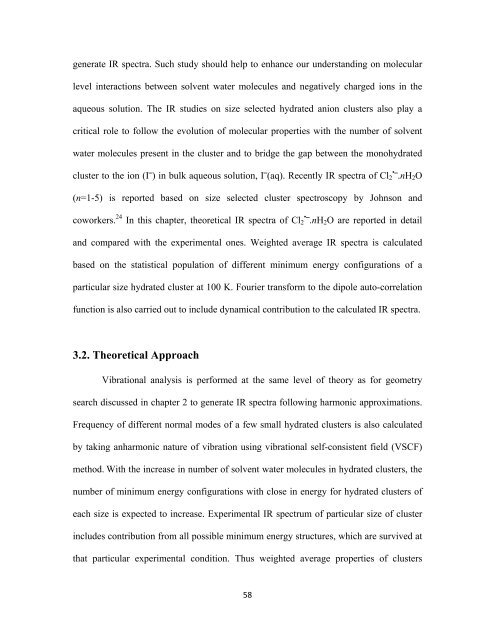CHEM01200604005 A. K. Pathak - Homi Bhabha National Institute
CHEM01200604005 A. K. Pathak - Homi Bhabha National Institute
CHEM01200604005 A. K. Pathak - Homi Bhabha National Institute
You also want an ePaper? Increase the reach of your titles
YUMPU automatically turns print PDFs into web optimized ePapers that Google loves.
generate IR spectra. Such study should help to enhance our understanding on molecular<br />
level interactions between solvent water molecules and negatively charged ions in the<br />
aqueous solution. The IR studies on size selected hydrated anion clusters also play a<br />
critical role to follow the evolution of molecular properties with the number of solvent<br />
water molecules present in the cluster and to bridge the gap between the monohydrated<br />
cluster to the ion (I⎯) in bulk aqueous solution, I⎯(aq). Recently IR spectra of Cl • 2 ⎯.nH 2 O<br />
(n=1-5) is reported based on size selected cluster spectroscopy by Johnson and<br />
coworkers. 24 In this chapter, theoretical IR spectra of Cl • 2 ⎯.nH 2 O are reported in detail<br />
and compared with the experimental ones. Weighted average IR spectra is calculated<br />
based on the statistical population of different minimum energy configurations of a<br />
particular size hydrated cluster at 100 K. Fourier transform to the dipole auto-correlation<br />
function is also carried out to include dynamical contribution to the calculated IR spectra.<br />
3.2. Theoretical Approach<br />
Vibrational analysis is performed at the same level of theory as for geometry<br />
search discussed in chapter 2 to generate IR spectra following harmonic approximations.<br />
Frequency of different normal modes of a few small hydrated clusters is also calculated<br />
by taking anharmonic nature of vibration using vibrational self-consistent field (VSCF)<br />
method. With the increase in number of solvent water molecules in hydrated clusters, the<br />
number of minimum energy configurations with close in energy for hydrated clusters of<br />
each size is expected to increase. Experimental IR spectrum of particular size of cluster<br />
includes contribution from all possible minimum energy structures, which are survived at<br />
that particular experimental condition. Thus weighted average properties of clusters<br />
58
















